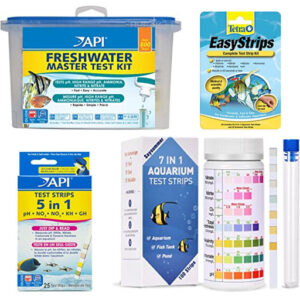The following article will examine some of the most common chemicals and minerals found in aquariums and how they may affect fish. It is essential to keep your aquarium water safe and healthy for fish, both freshwater and saltwater, by frequently testing it for all chemicals and minerals with Aquarium water test kits.
The different forms of toxins that can affect fish in aquarium
Just as humans can be poisoned by dangerous substances such as lead, fish can also be poisoned by dangerous substances such as mercury and other contaminants. Fish absorb these dangerous substances from their habitat or from the water they live in, hindering reproduction and growth. Also, fish are known to be susceptible to certain parasites and diseases that can be spread by the water.
Many of these substances come from pollution. These toxins come in different forms. Some are mutagenic and can cause cancer and other genetic mutations. Hence it becomes essential to test and treat aquarium water regularly and periodically. The easiest way to detect unsafe elements from aquarium water you are using which can harm your fish is using aquarium water test kits.

What is the purpose of an aquarium water test kit?
Aquarium water test kits have been a longtime favorite for monitoring the health of both fish and plants in an aquarium. These tests can be used to check the ammonia, nitrite, and nitrate levels in a tank, as well as determine if there is any chlorine or chloramine in the tap water being used. Buying a water test kit is the best way to ensure that your tank is safe for your fish and plants to thrive.
An aquarium water test kit sometimes also called as fish water testing kit. They are the must for any aquarium owner. There are many different tests that your local pet store will offer such as API Water Test Kit, 7-Way Aquarium Test Strips, API 5-in-1 Test Strips, jbl ammonia test kit, tetra easystrips, jbl freshwater test kit, Sera aqua test kits are to name few. But one of the most important is testing the ammonia levels in your tank. If you ever do not know what to buy, the ammonia test kit which are commonly known as ammonia tester or nh3 tester are a good kit to start.
What are the symptoms of unsafe aquarium water?
Here are one or more common symptoms of unsafe aquarium water:
Fish showing signs of stress
In the event that you notice any changes in your fish, such as abnormal movements, signs of stress, or erratic behavior, test your water quality to determine whether it is safe for your fish. Signs of stress can also be due to incorrect pH levels and ammonia poisoning.
Fish refusing to eat
Many people have pets that are fish, and they are just as much a part of the family as any other pet. Unfortunately, fish are often forgotten about when it comes to water quality. However, just like other pets, if the water is not safe for the fish, it will start to do irreversible damage to them. There are many causes of poor water quality for aquariums including ammonia or nitrites, so it is important these levels be tested regularly.
Fish not breeding
One of the most common problems with fish tanks is that the water doesn’t have enough salt to breed healthy fish. When this happens, it’s necessary to provide the appropriate amount of salt, by either adding more salt directly to the tank or using a solution to dissolve that amount into water. Please feel free to comment if you want me to cover detailed article on adding salt to aquarium water.
Fungal infection
The water in your aquarium can be a breeding ground for fungal infections, which have no cure. The most common type of infection is Ichthyophonus hoferi, often called ICH. It can lead to skin sores and other health problems, even death of your fish. If you are not sure whether the water in your tank is safe for fish, there are ways to check for fungus.
Also note that, not only do these symptoms affect your fish, but they also put your other pets at risk if their basking areas are next to the aquarium. If you notice these symptoms in your tank’s water, then you should replace or clean it with fresh water right away to save your fish from all of these risks. Apart from this, you should also check chlorine levels of your aquarium’s water. It’s very common for local water treatment authorities to treat tap water with high chlorine before supplying to households. Hence it becomes very important to regularly measure chlorine levels during aquarium water changeover.
How can you measure the chlorine level in your aquarium’s water?
It is important to ensure that the water in your tank remains safe for fish. Frequent measurements can be made to determine if there are any changes in chlorine levels. The following steps outline how to measure chlorine levels in your aquarium’s water:
- Chlorine test strips
- Chlorine test solutions
- DPD chlorine testing tablets
Conclusion
The purpose of this article is to provide a guide for the care and safety of your fish, as well as give you some general information on what makes aquatic conditions hazardous. Fish health can be damaged or killed by toxins in the water, so it is important to know if the water supply is safe for them. There are many tests to determine toxicity, but an easy way to assess whether fish will have a healthy life in the tank is to test the pH levels.
Low pH levels indicate that there may be ammonia or nitrates in the water and a high pH level indicates that there may be too many minerals in the water. It is very important to make sure that you monitor the pH levels of your aquarium so that your fish can live a healthy life. In case you want more information of test kits, feel free to drop your comment and we will try to respond as soon as we can. Or you can also contact us through our contact us form! Till then, happy petting! Do also check our product reviews here.

I’m John S, and I’m thrilled to share my passion for fishkeeping with you. With over 15 years of experience under my belt, I’ve swum through the highs and lows of aquarium maintenance, and I’m here to make your aquatic journey as smooth as possible.